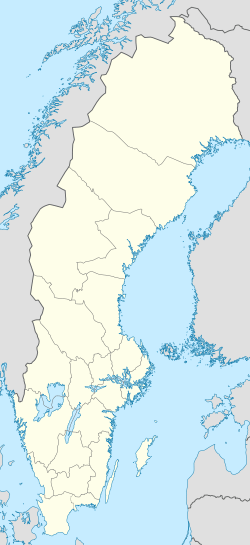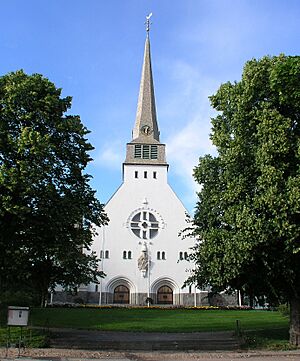Arvika facts for kids
Quick facts for kids
Arvika
|
|
|---|---|

Central Arvika in June 2004
|
|
| Country | Sweden |
| Province | Värmland |
| County | Värmland County |
| Municipality | Arvika Municipality |
| Established | 1911 |
| Area | |
| • Total | 10.62 km2 (4.10 sq mi) |
| Elevation | 58 m (190 ft) |
| Population
(31 December 2010)
|
|
| • Total | 14,244 |
| • Density | 1,341/km2 (3,470/sq mi) |
| Time zone | UTC+1 (CET) |
| • Summer (DST) | UTC+2 (CEST) |
| Postal code |
671 xx
|
| Area code(s) | (+46) 570 |
Arvika is a town in Sweden. It is the main town of Arvika Municipality in Värmland County. In 2010, about 14,244 people lived there.
Contents
Exploring Arvika's Location
Arvika is located by Kyrkviken. This is a bay of Glafsfjorden. Glafsfjorden is special because it's Sweden's only inland fjord. A fjord is a long, narrow, deep inlet of the sea between high cliffs. This one was formed after the last ice age.
The town is about 380 km (236 miles) west of Stockholm. It's also 250 km (155 miles) north of Gothenburg. Oslo, the capital of Norway, is about 150 km (93 miles) to the west. The border with Norway is only 50 km (31 miles) away.
The area around Arvika has many hills. The tallest hill near the town center is called Storkasberget.
Waterways and Connections
Arvika has great access to water. It even has Sweden's innermost harbor. This means ships can travel far inland to reach it.
Through a system of canals, boats can reach Lake Vänern. From there, the Göta Canal connects to Gothenburg. This allows passage all the way to Sweden's west coast.
Arvika's Past: A Brief History
Evidence of early life has been found near Arvika. About ten kilometers west of the town, in Bergs Klätt, there are old graves. These graves show that people lived here during the younger Stone Age and Nordic Bronze Age.
Arvika started as a small village. In 1811, it was given "town privileges" by the king. This meant it could act more like a city. It was even named Oscarsstad. The idea was to help the local economy grow.
However, this plan did not work well. In 1821, Arvika lost its town privileges. It became a "köping," which is like a smaller market town. Its name was changed back to Arvika.
The town privileges were given back in 1911. This was 100 years after it first became a town. The name Arvika stayed. Today, the idea of "city status" is not as important. But since 1971, Arvika has been the main town of the larger Arvika Municipality.
There are two old churches in Arvika. Mikaelikyrkan was built in 1647. Trefaldighetskyrkan, in the town center, was built in 1911. This was the same year Arvika became a town again.
What Arvika Makes: Local Industry
Arvika has several important factories. These factories provide many jobs for the people living there.
Some of the main companies include:
- Thermia: They make heating products.
- Volvo Construction Equipment: This factory makes large machines called wheel loaders. These are used in construction.
- Arvika Gjuteri: This is a foundry that makes metal parts. They work with different types of iron.
- Coffee Queen: This company makes coffee machines.
Arvika's Creative Side: Culture and Arts
Arvika is known for its art history. Around the year 1900, a group of artists lived and worked together. This group was called Rackstad. It was just outside the city.
Many famous Swedish artists were part of this group. Some of the most well-known were Christian Eriksson and Gustaf Fjæstad. Gustaf's wife, Maja Fjæstad, was also a talented artist. Other artists who lived in Rackstad included Björn Ahlgrensson and Fritz Lindström.
Arvika is also home to Jacob De La Rose. He is an NHL player who was chosen by the Montreal Canadiens in 2012.
Music and Festivals
The Arvika Festival was a big yearly event. It started in 1992. Many international bands came to play music for three days every July. Some famous bands that performed there include Depeche Mode, Nine Inch Nails, and Kraftwerk. The festival in 2009 was the biggest one ever.
Arvika is also home to Ingesund College of Music. This is one of only six university colleges of music in Sweden. It is part of Karlstad University.
Arvika's Climate
Arvika has a humid continental climate. This means it has warm summers and cold winters. The highest temperature ever recorded in Arvika was 33.9 degrees Celsius (93 degrees Fahrenheit). This happened on August 7, 1975. The lowest temperature recorded was -38.0 degrees Celsius (-36.4 degrees Fahrenheit) on February 9, 1966.
Arvika and Its Friends: International Relations
Arvika has three "twin cities." These are cities in other countries that have a special friendship with Arvika.
| Kongsvinger, Norway | |
| Skive Municipality, Denmark | |
| Ylöjärvi, Finland | |
| Szigetszentmiklós, Hungary |
See also
 In Spanish: Municipio de Arvika para niños
In Spanish: Municipio de Arvika para niños



